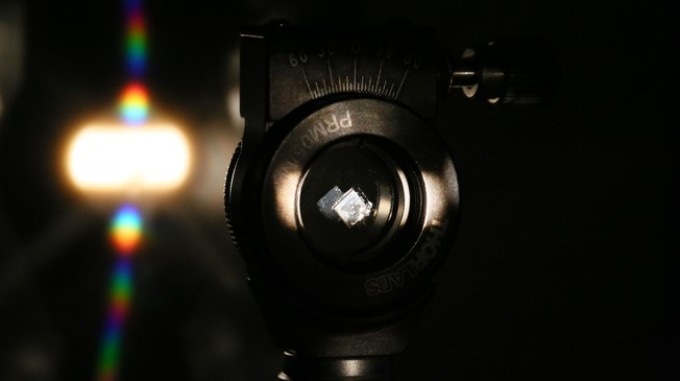Sep 5 2017
EPFL Researchers have developed a novel technique to microscopically cut diamonds into a specific shape and smooth them down at an atomic level. Thanks to this latest method, optical diffraction gratings with incredibly smooth surfaces can now be manufactured from pure diamonds.
Pure diamonds have special properties that are perfect for spectroscopy as well as optical components employed in high-powered lasers. The new method will be presented at the International Conference on Diamond and Carbon Materials DCM2017 on 5th September.
 © Alain Herzog / EPFL 2017
© Alain Herzog / EPFL 2017
Diffraction gratings are novel devices that are made up of parallel grooves, which break up light into its spectral components, similar to a prism. Usually, these gratings are made out of silicon and glass – materials that have already been employed in cutting-edge spectrographs and to modify the color produced by lasers.
Headed by Niels Quack, a SNSF-funded Professor at the School of Engineering, the research team has now discovered a new way to make these gratings from a single crystal diamond, paving the way to many new possibilities. Diamonds are unrivaled in terms of their thermal conductivity, which is five to ten times greater than that of all materials employed for this purpose. In addition to being hard, diamonds also work well with UV rays, visible and infrared beams.
Diamonds are chemically inert, which means that even the most aggressive chemical substances can't attack them. But it also means that they are very difficult to machine. So this new way of carving diamonds could prove very useful.
Dr. Niels Quack, a SNSF-funded Professor, the School of Engineering
Using oxygen to cut diamonds
EPFL Researchers have indeed developed a groundbreaking technique because it enables them to etch clearly defined shapes into tiny single-crystal diamond plates, with extraordinarily smooth surfaces and with the grooves isolated by only a few microns. In order to develop the technique, the team used diamonds that were synthetically produced by chemical vapor deposition.
Several stages are involved in the diamond etching process. A hard mask is first deposited and structured on a diamond plate surface, which is eventually subjected to an oxygen plasma. The oxygen ions present in the plasma are accelerated onto the diamond surface through an electric field.
In areas where the hard mask does not cover, the oxygen ions remove carbon atoms from the surface of the diamond one by one.
By adjusting the intensity of the electric field, we can alter the shape we etch into the diamond. For the diffraction gratings, we carve out triangular grooves that are just a few microns apart from each other. We adjust the process parameters to selectively reveal a set of well-defined crystal planes, allowing us to create V-shaped grooves that are smoothed down almost to the atomic level. It is impossible to get this kind of precision when the diamonds are simply cut with a laser.
Dr. Niels Quack, a SNSF-funded Professor, the School of Engineering
This latest technology, developed using the facilities in the Center of MicroNanoTechnology (CMI), is the subject of a new patent application.
Although the same method has already been employed using silicon, this was the first time that it has ever been demonstrated in diamond. In view of the significance of this contribution, Doctoral Student Marcell Kiss has been selected as one of the six finalists of the Young Scholar Award DCM2017.
The Researchers are collaborating on this development with LakeDiamond SA, a Swiss manufacturing company of high purity single crystal diamond substrates.
The Swiss National Science Foundation (SNF) and the Gebert Rüf Stiftung have funded the study.